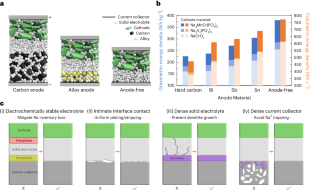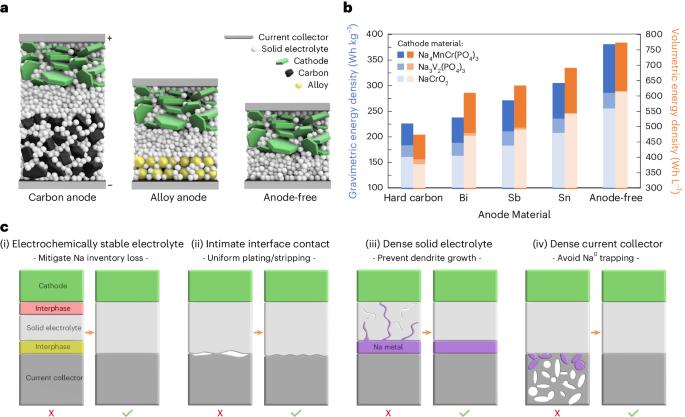实现无阳极钠全固态电池的设计原则
IF 60.1
1区 材料科学
Q1 ENERGY & FUELS
引用次数: 0
摘要
无阳极电池具有重量轻、体积小和成本低的优点,是最佳的电池结构。然而,不稳定的阳极形态变化和阳极-液体电解质界面反应限制了它们的应用。在这里,我们展示了电化学稳定的固体电解质和堆栈压力的应用,可以通过沉积致密的金属钠来解决这些问题。此外,我们还发现铝制集流器能与固体电解质实现紧密的固-固接触,从而实现高面积容量和高电流密度下的高度可逆钠电镀和剥离,这在以前的传统铝箔上是无法实现的。演示的无钠阳极全固态电池全电池可稳定循环数百次。这种电池结构是其他电池化学的未来发展方向,可实现低成本、高能量密度和快速充电电池。本文章由计算机程序翻译,如有差异,请以英文原文为准。


Design principles for enabling an anode-free sodium all-solid-state battery
Anode-free batteries possess the optimal cell architecture due to their reduced weight, volume and cost. However, their implementation has been limited by unstable anode morphological changes and anode–liquid electrolyte interface reactions. Here we show that an electrochemically stable solid electrolyte and the application of stack pressure can solve these issues by enabling the deposition of dense sodium metal. Furthermore, an aluminium current collector is found to achieve intimate solid–solid contact with the solid electrolyte, which allows highly reversible sodium plating and stripping at both high areal capacities and current densities, previously unobtainable with conventional aluminium foil. A sodium anode-free all-solid-state battery full cell is demonstrated with stable cycling for several hundred cycles. This cell architecture serves as a future direction for other battery chemistries to enable low-cost, high-energy-density and fast-charging batteries. Anode-free batteries are cost effective but limited by unstable anode morphology and interface reactions. Here the authors discuss design parameters and construct an anode-free sodium solid-state battery using compressed aluminium particles as the anode current collector to improve cycling performance.
求助全文
通过发布文献求助,成功后即可免费获取论文全文。
去求助
来源期刊

Nature Energy
Energy-Energy Engineering and Power Technology
CiteScore
75.10
自引率
1.10%
发文量
193
期刊介绍:
Nature Energy is a monthly, online-only journal committed to showcasing the most impactful research on energy, covering everything from its generation and distribution to the societal implications of energy technologies and policies.
With a focus on exploring all facets of the ongoing energy discourse, Nature Energy delves into topics such as energy generation, storage, distribution, management, and the societal impacts of energy technologies and policies. Emphasizing studies that push the boundaries of knowledge and contribute to the development of next-generation solutions, the journal serves as a platform for the exchange of ideas among stakeholders at the forefront of the energy sector.
Maintaining the hallmark standards of the Nature brand, Nature Energy boasts a dedicated team of professional editors, a rigorous peer-review process, meticulous copy-editing and production, rapid publication times, and editorial independence.
In addition to original research articles, Nature Energy also publishes a range of content types, including Comments, Perspectives, Reviews, News & Views, Features, and Correspondence, covering a diverse array of disciplines relevant to the field of energy.
 求助内容:
求助内容: 应助结果提醒方式:
应助结果提醒方式:


